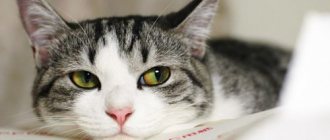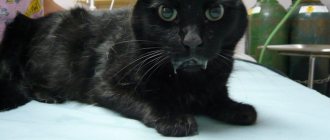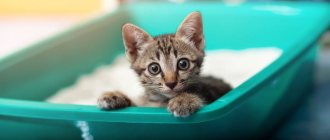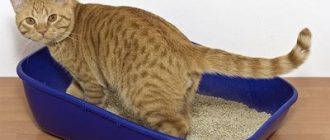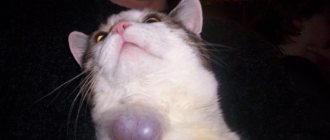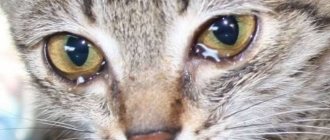( 2 votes, rating: 1.00 out of 5)
5589564
05/29/2021 owner reviews 2,
Have you noticed that your cat's back twitches after a few seconds of petting it? This is a common reaction in cats that may seem normal, but there is cause for concern if it happens frequently. Read on and let's unravel the truth beyond the back twitch phenomenon.
- Causes 1. It may be due to feline hyperesthesia syndrome
- 2. It may be due to the sensitive layer of muscle located on the cat's back.
- 3. Your petting may overstimulate your cat.
Causes
It is important to determine the reason why the animal twitches its back and tail. To do this, you should carefully observe the cat. The reasons can be both harmless and dangerous.
Safe Reasons
Cats have vibrissae, which are sensitive hairs in their fur, such as whiskers. On the back they are stiffer than the rest of the hair and may be white. They are designed for orientation in space. If you touch them, the animal will twitch the hair on its back. If you run it against the grain and ruin her hair or ruffle it, she will also twitch and then begin to lick herself, putting herself in order.
If your cat jerks its back or tail, it will be under stress. When she is scared, excited, nervous, she shows her condition by twitching . This phenomenon can often be observed during the mating season. Especially when the animal does not have the opportunity to walk and look for a partner for procreation. You can also observe twitching when she wants to go to the toilet. She may start running, meowing, and freaking out. Thus, by twitching the skin, the animal establishes peristalsis. This is normal behavior for her and should not cause alarm to her owners.
Dangerous reasons
Twitching of the skin on the back can be a sign that your cat's health is deteriorating. In such a situation, the main thing is not to delay and contact a specialist. The veterinarian will order tests, make a diagnosis and prescribe treatment.
A pet may jerk its back due to diseases such as:
- Rabies;
- Hyperesthesia syndrome;
- Cancerous tumors;
- Fleas.
If a cat roams freely on the street, it runs the risk of encountering another animal with rabies. The disease is transmitted through a bite. If you notice that your cat's back is twitching, he has attacks of aggression, is irritable, eats food but does not drink water, immediately take him to the doctor. These are symptoms of rabies.
If the disease is neglected, it will become dangerous for all family members. An animal infected with rabies can infect humans. If the symptom is confirmed by the veterinarian after tests, the cat will be euthanized. Unfortunately, veterinarians have not yet found effective treatment methods that can restore health to a pet.
Some young cats, under one year of age, develop hyperesthesia syndrome. Most often, purebred animals are susceptible to it. It is difficult to treat due to the fact that it has not been fully studied. The syndrome is accompanied by hypersensitivity and increased nervousness. The cat's condition changes from normal to aggressive, suddenly, as if a switch in her brain was switched. She can attack other animals or people. Biting your own tail. Small children should not be allowed near to protect the child from being bitten and scratched.
The first call is when the animal begins to take extra care of its fur. It constantly licks itself in the area of the back and tail . Such excessive care can lead to dermatitis, severe itching of the skin. In a cat in this condition, not only does the skin on its back twitch, but its hair also falls out, forming bald patches. The disease can be aggravated by a fungal infection. Treatment of hyperesthesia syndrome is carried out with special medications against seizures and sedatives.
A cat may twitch its back nervously, itch, and lick itself intensively due to fleas. Even if she is indoors and does not go outside, there is a risk of infection. People can bring them on their shoes. There are special drops and collars to combat them.
If a tumor forms in the spinal cord, the cat may nervously jerk its back. Treatment is carried out through surgery. This disease is rare, but the prognosis for the affected animal is disappointing.
Noticing symptoms in time is a step towards recovery. You can't run them. The veterinarian needs to be told about all the nuances of the animal’s behavior. Then the correct diagnosis will be made and the correct treatment will be prescribed.
Source
When to contact a veterinarian
If the owner, after analyzing his pet’s trembling on his own, does not find an explanation for it, he will have to immediately contact a specialist at the nearest veterinary clinic. As the animal begins to tremble, its behavior may change; overnight, a beloved cat may become aggressive. In addition to the reasons described above that cause tremors in a cat in a lying position, there are many other less harmless reasons that cause tremors.
These include:
- The cat has helminths.
- Lack of vitamins in the cat's body (especially calcium and vitamin B).
- Diseases of internal organs (in particular the kidneys - the presence of urolithiasis in the animal).
The veterinarian will send the animal along with the owner to undergo all the necessary tests and an ultrasound of the internal organs, and then give recommendations on the necessary treatment.
- Published in
- Health
What is feline hyperesthesia syndrome?
Feline hyperesthesia syndrome, which causes discomfort in cats, causes increased skin sensitivity.
Feline hyperesthesia syndrome is also often called twitching skin syndrome, twitching cat syndrome, rolling skin syndrome , atypical neurodermatitis, psychomotor epilepsy and neuritis. No matter what you call it, it's a condition that causes your kitty to experience increased skin sensitivity, so you can imagine how uncomfortable it can be.
Read the information below to learn more about feline hyperesthesia and what you can do if your cat has been diagnosed.
Causes
Feline hyperesthesia syndrome affects the skin as well as the neuromuscular and nervous systems. Unfortunately, experts are not entirely sure what may be causing this rare disease.
Some experts believe there may be a connection between epilepsy and hyperesthesia, or that dry, itchy skin caused by a deficiency of omega-3 fatty acids in the diet may contribute to symptoms. Others suggest that it is a form of obsessive-compulsive disorder or that it may be a result of the cat being stressed.
Rehabilitation
To strengthen the muscular-ligamentous structures and accelerate the restoration of the disturbed movement pattern, the following is carried out: physical therapy (exercises for stretching and relaxing tense muscles) post-isometric relaxation exercises on therapeutic exercise equipment A comprehensive program of physical rehabilitation for patients with reflex myotonic syndrome helps to effectively deactivate trigger points, eliminate muscle spasms and increase the range of motion in the affected parts of the spine.
Symptoms
Symptoms of feline hyperesthesia can develop at any age, and the condition can occur in all breeds. A cat that suffers from hyperesthesia syndrome may end up licking and biting its own body, such as its limbs, tail and back.
Here are some other signs that your cat may have hyperesthesia:
- The skin on your cat's back may range from the shoulders to the tail
- Your cat may suddenly jump and turn towards her tail as if something is bothering her
- You may notice muscle twitching, tail twitching, and/or muscle spasms
- Your cat may not like certain areas of its back to be touched when you go to pet it
- Your cat may act erratically, appear agitated, and have dilated pupils
- Your cat may cry, hiss, or suddenly run away, and you may think she's hallucinating because she looks like she's going after something that isn't there.
- Severe cases can lead to self-destruction through chewing, licking, fur pulling, and biting. As a result, lesions and infections may appear on the skin.
Typically, these symptoms occur in episodes that may last only a few seconds or a few minutes. In between episodes, your kitten will act as if everything is fine. However, touching your cat in the wrong place can trigger an episode.
Metabolic disorders
Failures in the functioning of internal systems disrupt metabolism and the rhythm of metabolic processes. This leads to an imbalance in the nervous system, and impulses are sent to the muscles “incorrectly,” which manifests itself in convulsions.
Metabolism-related diseases
| Name | Peculiarities |
| Eclampsia | It is observed during the period of gestation of kittens, at birth and feeding. A convulsive state develops against the background of a sharp decrease in the level of calcium in the blood and is accompanied by severe pain. In the initial stage, convulsive twitching is observed in the hind limbs. As the attacks progress, they become more frequent and affect the entire body. |
| Kidney failure | There are many factors that provoke this disease, from common infections to autoimmune pathologies. Failure of the kidneys interferes with the removal of toxins from the body. As a result, brain tissue is damaged. |
| Hypoglycemia | Blood glucose levels drop sharply. Convulsive attacks are accompanied by severe pain, causing the animal to writhe and scream loudly. This condition is similar to epileptic seizures |
| Intoxication | Toxic substances that enter a cat’s body have a negative effect on the nervous system. In mild cases, this provokes stool upset. In severe situations, intestinal bleeding is added to diarrhea. The cat is vomiting and writhing in convulsions |
Any disruption of metabolic processes if assistance is not provided in a timely manner will lead to the death of the pet.
Old age can also be included in this group of pathologies. In the body of old cats, degenerative processes occur that affect almost all organs, but the brain is the first to suffer.
Involuntary muscle twitching may be pre-death convulsions.
Treatment
If your kitten begins to show signs of feline hyperesthesia syndrome, it is a great idea to talk to your veterinarian, who will evaluate your pet and rule out other problems that have similar symptoms.
If hyperesthesia is the cause of your cat's symptoms, it is important to know that there is no definitive cure for this condition. Instead, your veterinarian may recommend giving your pet prescription medications such as anticonvulsants or antidepressants. Reducing your cat's stress and anxiety levels through environmental enrichment may also be helpful, or you may be advised to make changes to your kitten's diet. Additionally, natural remedies such as acupuncture, massage, and supplements may also be recommended.
Factors contributing to the development of tracheitis
An important factor contributing to the development of tracheitis is impaired nasal breathing. Normally, air should pass through the nasal passages, where it is warmed and moistened. If your nose is stuffy (the cause could be a runny nose, deviated nasal septum, adenoids, polyps, etc.), you have to breathe through your mouth. In this case, unprepared atmospheric air immediately enters the larynx and trachea. As a result, the tracheal mucosa may undergo:
- hypothermia;
- exposure to polluted or too dry air;
- exposure to allergens.
The development of tracheitis is also promoted by:
- smoking. Tobacco smoke irritates the mucous membrane of the respiratory tract;
- weakened immunity;
- alcohol abuse. Alcohol suppresses the immune system;
- diseases of the heart and kidneys, as a result of which the tissues of the mucous membrane do not receive sufficient nutrition, and some other diseases.
Messages [9]
1 Topic from Sasha 2009-02-23 07:43:20
Topic: Frequent back spasms in cats
Hello, my cat has been suffering from frequent back spasms for over a year now. Outwardly, this is expressed as follows: several times a day she jumps up because something under the skin begins to move quickly (it seems from the outside, as if there was some kind of ball under the skin that quickly and frantically moves along the back), then she begins to lick floor, run around the rooms, lick the floor again, and so on until the cramps in the back go away. This usually lasts half a minute, but occurs several times a day. I took her to two veterinarians, they can’t figure out what it is and are starting to make up assumptions and suggest medications. I don't want to feed the poor cat all sorts of chemicals without knowing exactly what she is suffering from. Otherwise she behaves normally, eats, sleeps, runs. Please, if anyone knows what this could be, help with advice on what to do.
2 Reply from Irina-Vet 2009-02-24 22:17:00
- Irina-Vet
- Moderator
- Inactive
- Registered: 2008-10-07
- Messages: 2,761
Re: Frequent back spasms in cats
Hello! Neurological pathology has not been sufficiently studied in cats and is very difficult to diagnose. Most likely, the cause of such “convulsions” will remain unclear.
3 Reply from Sasha 2009-02-25 14:12:50
Re: Frequent back spasms in cats
This cannot be a subcutaneous mite or does it not express itself with convulsions?
4 Reply from Irina-Vet 2009-02-25 22:46:17
- Irina-Vet
- Moderator
- Inactive
- Registered: 2008-10-07
- Messages: 2,761
Re: Frequent back spasms in cats
No, this is not a subcutaneous mite :)
5 Reply from dimagubin 2010-01-18 21:48:54
Re: Frequent back spasms in cats
The cat has a very similar situation. The veterinarian said it was due to parasites under the skin, but treatment did not get rid of the seizures. It feels like the cat has nerve problems. A domestic cat with a non-stressful lifestyle, gives birth once a year, in other cases of estrus a pilkan is given. Tell me, are there any sedatives (non-hormonal) for cats? Is it possible to give valerian? Thank you
Messages
Pages 1
To post a reply you must log in or register.
Vetlek » Consultation with a veterinarian » Frequent back spasms in a cat
Powered by PunBB , powered by Informer Technologies, Inc.
This is interesting: What to do if the cat doesn’t go to the toilet at all?
Why does the cat shake its tail?
The tail of cats serves primarily as an indicator of mood. By moving it, they express:
- Anxiety. By wagging its tail and pressing its ears to its head, the pet shows that something is bothering it.
- Willingness to engage in combat with a possible enemy or pursue a victim.
- Doubt.
- Pleasure. Cats wag the tip of their tail when they are happy and try to show their owners the depth of their overwhelming feelings.
- Curiosity. When a pet explores something with interest, its tail twitches.
- Irritation. If an animal actively swings its tail from side to side, it means it is irritated.
Caution - rabies
If the cat is free-range, its behavior must be observed especially carefully. On the street there is a high risk of contracting various infectious diseases, many of which are fatal.
Having noticed a twitching of the tail and back of a freedom-loving cat, the owner needs to sound the alarm and find out why this is happening. These symptoms are often used to identify rabies. This disease is dangerous for both the pet and its owner. It threatens irreversible damage to the spinal cord and brain. In addition to the fact that the animal begins to twitch its tail and back, there are other signs of rabies:
- the cat eats food but refuses to drink water;
- the animal becomes aggressive or, conversely, tries to hide from people;
- have difficulty swallowing food;
- saliva is produced profusely;
- the pet begins to constantly bite itself at the place through which the infection entered the cat’s body.
But whatever the symptoms, only a veterinarian can accurately answer the question of why the cat is twitching its tail. However, if rabies is confirmed, the animal will have to be euthanized.
There are a number of reasons why a cat shakes its tail, the most mobile part of its body. As an extension of the spine, the tail is equipped with a dense network of nerve fibers. Thanks to this, various movements are considered by a person as a kind of “language” of the pet and allow the owner to understand his cat. Unlike dogs, cats convey many emotions with their tail.
The cat's tail and skin on its back twitch - why and what does this mean?
Cat owners sometimes observe the following picture: the pet's tail twitches, as if he is marking territory, and the skin on his back shakes, as if he is trembling in this particular part of the body. This phenomenon may have physiological and pathological causes. Regardless of what exactly led to the twitching of the tail and skin, the four-legged pet in this situation requires the help of the owner.
The animal has fleas or other ectoparasites
If an adult cat or kitten twitches its tail, while the skin on its back trembles, it may be overcome by ectoparasites (those that parasitize not under the skin, but on its surface): fleas, lice eaters, ticks. In addition to these symptoms, external parasites manifest themselves as follows:
- bite marks on the body in the form of small red dots;
- unbearable itching in the affected areas;
- constant scratching in an attempt to somehow relieve the itching from the bites;
- jumping black dots, grains that look like dirt;
- deterioration of the coat (loss, loss of shine, fragility);
- sleep disturbance – due to constant itching, the cat hardly sleeps;
- complete or partial lack of appetite;
- anxiety, lack of interest in games, apathy;
- ulceration of the affected skin, scabs;
- reduction in body weight.
The cat is nervous
Is your pet shaking its tail? This may be a sign of anxiety. Don't confuse anxiety with stress. Both of these conditions are associated with negative emotions, but in the first case they are not as pronounced as in the second. Anything can cause anxiety in a cat. She may get nervous because of a large crowd of people in the house, the appearance of a stranger in it, the long absence of the owner, etc.
In order for the pet to calm down, you need to pick it up, caress it, and talk to it. It is best to try to switch the animal's attention to something else, such as a game. By spending time actively and having fun, it will forget about worries.
The first signs of ischemic stroke
An attack can develop over several hours, and sometimes symptoms increase over the course of a day.
| If assistance for a stroke is provided within the first 3-6 hours - the golden therapeutic window - then severe brain damage can be avoided. |
- A person often has a headache. The localization of pain is difficult to determine. The pain is usually difficult to relieve with medications.
- Muscle weakness occurs, any movement is difficult.
- The person becomes unusually apathetic. Household chores cause him difficulties, and he loses his ability to work.
- Dizziness occurs. They appear even at rest, and intensify when moving.
- Blood pressure “jumps”, which was not the case before.
- Noisy in the ears. Sometimes this feeling can be permanent.
- Memory impairment occurs. It may be difficult for a person to remember recent information.
- Hands and feet, face go numb.
- Sleep disturbances occur. A person sleeps poorly at night and is drowsy during the day. Even after a long rest, you do not feel invigorated.
- Stereoscopic (three-dimensional) vision appears.
- Coordination of movements is impaired.
These signs can appear, disappear, and then return with renewed vigor. If these symptoms appear, it is necessary to begin treatment without delay.
Why does the animal run and nervously lick itself?
Licking is normal for cats. These clean animals are so sensitive to the cleanliness of their fur that they lick themselves at every opportunity: after eating, going to the toilet, or being touched by their owners. Moreover, by licking their fur coat, they calm down. Licking can be talked about as a normal phenomenon only when it is not fanatical in nature. Why does a kitten or adult cat run around the house and lick nervously?
The cat is stressed
These animals have a very vulnerable psyche. It doesn’t take much for a pet to lose its peace of mind. This can happen due to a trip in a car, a visit to the veterinarian, quarrels in the family, the appearance of a new four-legged inhabitant in the house, moving to another room, changing place of residence, etc. All cats experience stress differently. Some begin to run aimlessly around the apartment and fanatically lick the fur. Sometimes they do this so violently that in some areas of their bodies they become completely bald.
As soon as the factor that provoked the cat’s emotional shock disappears or he gets used to new circumstances, the pet will stop being nervous. However, cats are not always able to overcome stress on their own. Sometimes they need sedatives.
Hyperesthesia syndrome
This rather rare disorder, affecting the skin, neuromuscular and nervous systems, is most often detected in kittens. The reasons for its appearance are unknown, but it is believed to be due to disruption of neurotransmitters in the brain during anxiety.
Animals with this syndrome feel tense all the time and experience increased sensitivity to touch. Their spine and tail are the most vulnerable. They lick the fur too diligently, paying special attention to the most vulnerable areas of the body, sometimes leading to the appearance of bloody wounds. Hyperesthesia syndrome can also be recognized by other symptoms:
- nervous tail beating;
- twitching of parts of the body in the back;
- sudden bursts of activity, sometimes developing into aggression;
- dilated pupils;
- tail biting;
- loud meow.
With brain damage
Pathologies affecting this organ are the most dangerous. Defeat can be caused by both external factors and internal processes.
Causes
| Disease | Peculiarities |
| Tick-borne encephalitis | When an ixoid tick bites, an infection enters the cat's body with the insect's saliva, causing the disease. Characteristic signs other than seizures:
|
| Hypoxia | Oxygen starvation can occur for a number of reasons, but in any case it leads to damage to brain tissue. At first, the symptoms are mild, and the seizures are so short-lived that the owner may simply not notice them. As the pathology develops, the number of convulsions and their duration increase. Hypoxia can be suspected by suddenly appearing shortness of breath, fainting, or cyanosis of the mucous membranes. |
| Rabies | Not just dangerous - a fatal disease caused by Babes Negri bodies. The animal's hind legs twitch first, then its limbs become paralyzed. While the cat is able to move, it shows strong aggression. The disease develops rapidly. Spasms pass from the body muscles to the respiratory muscles, and the animal dies from suffocation |
| Tumors | The initial stage of oncology has no obvious symptoms. They will appear when the tumor, growing, begins to put pressure on important areas of the brain. The animal's behavior changes: the cat becomes aggressive, loses orientation - constantly bumps into walls, objects, and monotonously circles in one place. The disease is often accompanied by convulsive seizures |
| Hydrocephalus | The cause is disruption of the outflow of fluid from the brain. The pathology is congenital and can be detected at an early stage. A kitten suffering from hydrocephalus has a larger skull volume than healthy babies, and it lags behind its brothers in development. The disease manifests itself as clonic convulsions, the first signs of which can be noticed at 2 months of age. The rapid development of pathology leads to death |
| Hematomas, injuries | Damage to the skull is accompanied by profuse vomiting. With severe injuries, loss of consciousness, paralysis of a group of muscles and twitching of those that hold the eyeballs are possible. |
Even an unbalanced diet, which provokes the development of vitamin deficiency, can cause brain damage.
In particular, this concerns vitamin B1 (thiamine), which is necessary for the smooth functioning of systems. The initial stage is manifested by trembling of the limbs; with severe deficiency, convulsions are observed.
